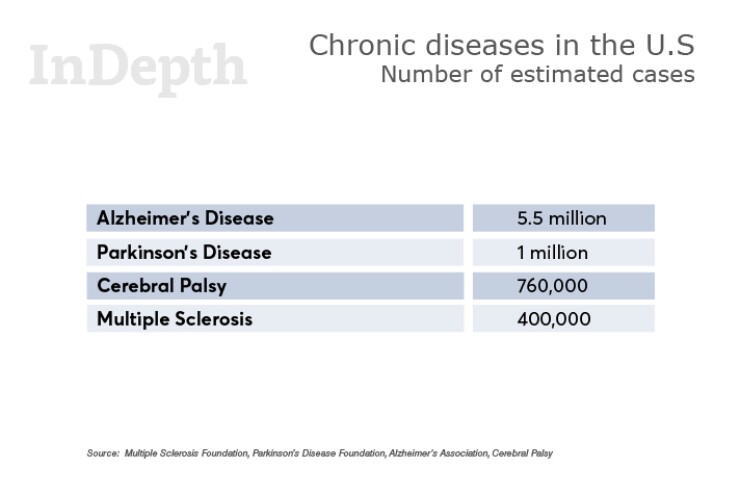Gina O’Callaghan’s client had more reason than most not to want to peer too far ahead to her old age. She had been diagnosed decades ago with multiple sclerosis, a chronic disease that would more than likely incapacitate her.
In her 60s and able to drive, the prospect of walkers and wheelchairs was still a long way off, she thought.
But O'Callaghan knew better. Her client was getting ready to retire as a schoolteacher and she could not put off thinking about a worst-case scenario any longer, particularly since she was estranged from her family.
“Because she's had this adversity in her family life, she's always wanted somebody to take care of her,” O'Callaghan, an advisor at Ventura County Credit Union in Thousand Oaks, California, said.
O’Callaghan learned that while her client didn’t have family members looking out for her, she nevertheless desired to be cared for at home so she wouldn't have to part with her dogs, which she referred to as "her babies," said O'Callaghan.
With her wishes in mind, O'Callaghan got to work devising a plan that would allow her client to live comfortably in her home. The now nearly 80-year-old client receives round-the-clock care from home care providers at a cost of more than $8,000 a month, thanks to the robust financial plan she put in place.
NAVIGATING FAMILY DYNAMICS
Financial planning for clients such as O'Callaghan's isn't easy. Advisors must contend not only with the emotional and psychological issues facing their clients. They often must also navigate complex family relationships, while juggling a slew of unique financial challenges that don't always have easy fixes.
Higher medical expenses are just the beginning. Clients diagnosed with progressive diseases don't qualify for long-term care or disability insurance, two key tools that ordinarily would have been used to help offset the risk of a catastrophic illness or injury. With advances in medical technology, clients may live in an incapacitated state for an extended period of time, further spiking their healthcare costs. It's also tricky to plan given the unpredictable trajectory of many degenerative diseases. Some follow a set course of deterioration, while others do not.

Unlike most people with chronic diseases, O’Callaghan’s client was not even eligible for Social Security disability benefits. She received a teacher's pension from the State of California, which automatically disqualified her.
Fortunately, she received enough from her pension and other sources and had enough in savings that O’Callaghan was able to cobble together a two-tier plan to meet her needs. O'Callaghan placed her money in two buckets, the bulk of it going into a managed account, where the funds are readily available. The rest of her money went into variable annuities with income riders that guaranteed growth to the income base regardless of how the market performed. Two years ago, O'Callaghan "turned on" all the income from these annuities, providing the client with an income stream she is unlikely to outlive, according to O'Callaghan.
25-YEAR TIME HORIZON
Laura Steckler, an advisor with Raymond James' Steckler Wealth Management Group in Coral Gables, Florida, developed a long-term financial plan for a client who was diagnosed with Parkinson’s disease seven years ago at the age of 53.
“We potentially have to fund a 25-year time horizon,” Steckler said, referring to the period after the client’s 65th birthday.
Her client, a successful owner of a hair salon, was in a better initial financial situation than most. He had had the foresight to take out disability insurance many years prior to his diagnosis and is now receiving a monthly benefit of $7,000, which he will receive for another five years.
Still, he and his wife were worried. They wondered whether they would be able to sustain themselves financially once his disability benefits ended.
The couple had already sold the business but the proceeds from the sale were not enough to "even make a dent in the level of security they would need for retirement," Steckler said.
One of the first things she had the couple do was analyze and adjust their spending habits. They cut down on their travel and social activities in a bid to have more money on hand when his disability check went away.
They also plan to sell their primary residence and downsize to a smaller house in another part of Florida with a lower cost of living. They will also downsize to one car when he becomes unable to drive.

SHORTENED WORK-LIFE EXPECTANCY
People with chronic or degenerative diseases have to plan for a shortened work-life expectancy, says Paul Stark, a wealth and estate planning strategist with SunTrust Private Wealth Management in Charlotte, North Carolina. "They need to start planning right away for the end of their income and how they're going to deal with the fact that they probably will be retiring early involuntarily," he said.
They also need to adjust their priorities. If they always wanted to travel, they might want to make that more of a priority while they're still physically able to do so.
Bryan Koepp, a senior wealth management strategist with Regions Bank in Atlanta, recalled a client who was diagnosed with Alzheimer's. He decided to prioritize spending more time with his grandchildren and family, who were spread throughout the country.
"We try to get clients to focus on what's most important to them in that moment and in the days and weeks ahead to ensure they live the life they want to have," Koepp says.
Long-term-care policies typically have a 90- to 180-day exclusion period, the period from when a condition is diagnosed to when the policy begins paying benefits.
Clients with chronic diseases should also review their life insurance policies to see if they have disability riders. They should make sure that premiums are paid and that the beneficiaries are correct.
If they're lucky enough to have a long-term-care policy in place, they need to determine whether it will cover their condition as well as how much and when it will pay. Long-term-care policies typically have a 90- to 180-day exclusion period, the period from when a condition is diagnosed to when the policy begins paying benefits.
THE DIFFICULT QUESTIONS
Once the short-term action steps are out of the way, the hard work begins. Advisors need to help their clients face difficult questions, such as who to appoint to make health care and financial decisions on their behalf when they they're unable to do so. It's a sensitive matter, particularly if the client is independent and is reluctant to give up control. Some clients fear that the person they appoint may not abide by their wishes.
For Laura Steckler's client and his wife, the decision was very emotional. It was hard for the wife to "think about when he gets worse," Steckler says.
The couple decided that the wife would be given a power of attorney for both financial and medical matters. They also decided that she would provide his care at least initially. If she found that she couldn't manage, they would adjust the financial plan to budget for home health aides or an assisted-living facility.
People with degenerative diseases need to start planning right away for the end of their income and how they’re going to deal with the fact that they probably will be retiring early involuntarily, says SunTrust’s Paul Stark.
The decision to designate powers of attorney is not only emotional. It may also produce hurt feelings, particularly if the client has more than one child. When one is chosen over another, it could raise questions of favoritism, says Keopp.
Wendy Johnson, a compliance officer with U.S. Bancorp Investments in Minneapolis, urges advisors to gather the family together so that everyone knows “what’s going on and what mom and dad’s wishes are.” She reminds advisors that they are advocates for their clients, not their client’s children or assigned powers of attorney.
“Children and powers of attorneys can stand besides your client and assist them but they should never stand in place of your client,” she says.
INCAPACITY
Powers of attorney are important but may not be enough to protect a client's assets from guardianship if he or should become incapacitated. Clients should consider setting up a trust, a legal entity created to hold ownership of an individual's assets.
Many financial institutions will scrutinize powers of attorney more than they will a trust, which contains detailed instructions on how to carry out a person's financial affairs. Trusts typically designate a successor trustee, someone to step in and take over management of the trust if the trust-maker becomes incapacitated.
“Even people of modest means may want to consider having a trust because that will avoid guardianship of their assets," says Stark, explaining that powers of attorney don't always do the trick.
Banks believe there is a greater risk of elder abuse when dealing with powers of attorney than with successor trustees. As such, they will often reject powers of attorney for lack of specific terminology or even consider them invalid if too much time has elapsed since they were executed, according to Stark.
Stark was recently on a call with an attorney whose client’s mother’s power of attorney was rejected by a local bank because it was too old. The bank refused to honor the power of attorney even though under state law there was no period of expiration for a power of attorney. Because the woman was incapacitated and unable to execute any new legal documents, she is likely to be appointed a guardian.
In addition to a trust, a client with a debilitative disease should draw up a will if they have young children. Wills spell out who should care for their children in the event they're unable to.
If they’re married, they also need to think about their spouses. Steckler’s client, the former hair salon owner who has Parkinson’s disease, was concerned that they would spend down their assets for his care, leaving his wife with little to live on. He expected his wife, 56 and in good health, to outlive him.
Fortunately, his wife was still eligible for long-term-care insurance. Steckler is close to securing a policy for her that will cover home care as well as assisted-living and nursing home facilities. If the policy is approved, she will receive benefits for a minimum of six years with the amount dependent on when she goes on claim. If she goes on claim at 80, she will receive a maximum monthly benefit of $6,560 for a total maximum benefit of $472,000. She will pay $50,000 over 10 years for the policy.
Right now, Steckler's client is enjoying his life, traveling, boating and going out with friends, but he knows he's going to deteriorate. The key, says Steckler, is future planning, not just focusing on today but on the years to come for both himself and those who support him.





